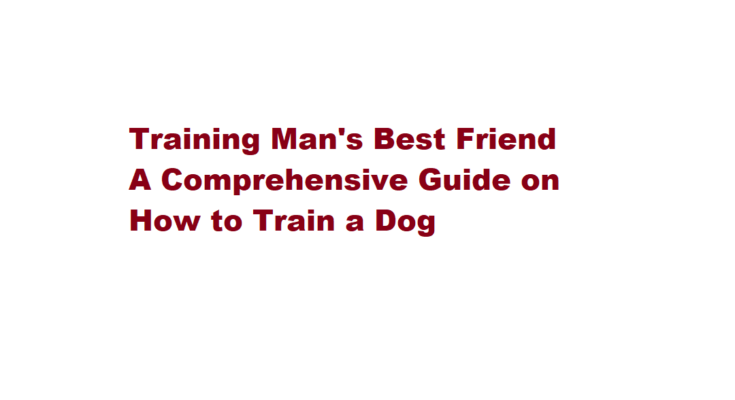Introduction
Dogs, often referred to as man’s best friend, have shared a unique bond with humans for thousands of years. From loyal companions to diligent workers, dogs have proven their worth in various roles. One crucial aspect of this partnership is training. Properly training your dog not only enhances their quality of life but also strengthens your relationship. In this article, we will delve into a comprehensive guide on how to train a dog effectively.
Understanding Dog Behavior
Before embarking on any training journey, it’s crucial to understand the fundamentals of dog behavior. Dogs are pack animals with a natural instinct to follow a leader. Establishing yourself as the pack leader is the foundation of successful training. Here are some key aspects to consider
1. Communication – Dogs primarily communicate through body language and vocalizations. Pay close attention to your dog’s cues to understand their feelings and needs.
2. Positive Reinforcement – Dogs respond well to positive reinforcement, such as treats, praise, and affection. Rewarding desired behaviors encourages them to repeat those actions.
3. Consistency – Consistency is key in dog training. Be consistent with commands, rewards, and rules to avoid confusion.
4. Patience – Training takes time and patience. Every dog learns at its own pace, so avoid frustration and stay committed.
Basic Dog Training Commands
Training starts with teaching basic commands that lay the groundwork for more advanced skills. Here are some essential commands
1. Sit – Teaching your dog to sit is one of the first and most basic commands. Hold a treat above their head and slowly move it back while saying “sit.” When their bottom touches the ground, reward them.
2. Stay – Teaching your dog to stay is essential for safety. Start by having your dog sit, then extend your hand, palm out, and say “stay.” Step back a few paces and return to reward them if they remain in place.
3. Come – The “come” command is crucial for recall. Say “come” while patting your thigh and rewarding them when they approach. This command is essential for their safety outdoors.
4. Down – Similar to “sit,” teaching your dog to lie down on command is essential for their obedience. Use a treat to guide them into the down position and reward them when they comply.
5. Leave it – This command helps prevent your dog from picking up potentially harmful objects or chasing after something. Hold a treat in a closed hand and say “leave it.” Only reward them when they stop trying to get the treat.
6. Heel – Teaching your dog to walk politely on a leash is crucial. Use treats to reward them for walking by your side without pulling.
Socialization
Socializing your dog is a critical aspect of their training. Proper socialization helps your dog become well-adjusted, confident, and comfortable in various situations. Expose your dog to different people, animals, and environments from a young age. Gradually increase the level of exposure as they become more comfortable.
Addressing Behavioral Issues
While teaching commands is essential, addressing behavioral issues is equally important. Here are some common behavioral problems and how to tackle them
1. Barking – Excessive barking can be annoying. Teach the “quiet” command and reward your dog for silence.
2. Aggression – Address aggression with professional help if necessary. Avoid confrontations and use positive reinforcement to encourage non-aggressive behavior.
3. Chewing – Provide appropriate chew toys and discourage destructive chewing by redirecting them to the toys.
4. Separation Anxiety – Gradually desensitize your dog to your absence by leaving for short periods and gradually increasing the duration.
5. House Training – Establish a routine for bathroom breaks and reward your dog for going outside. Clean up accidents promptly to eliminate odors.
Advanced Training
Once your dog has mastered basic commands and behavior, you can move on to advanced training. Advanced commands like “stay” for extended periods, “roll over,” and “fetch” can be taught to stimulate your dog mentally and physically.
Remember, advanced training requires more time and patience. Be sure to continue using positive reinforcement techniques and keep training sessions short and engaging.
Frequently Asked Question
What is most important in training a dog?
All training should be reward based. Giving your dog something they really like – such as food, toys or praise – when they show a particular behavior means that they’re more likely to do it again. It’s important to find out what your dog really likes and what their favorite things are.
What are the basic commands for a dog trainer?
When you get a new dog, whether it’s a puppy or an adult rescue, she probably needs some obedience training. More specifically, a well-behaved pup should respond to seven directions in order to become a good canine citizen: Sit, Down, Stay, Come, Heel, Off, and No.
Conclusion
Training a dog is a rewarding journey that strengthens the bond between you and your four-legged friend. Understanding dog behavior, teaching basic commands, proper socialization, and addressing behavioral issues are all crucial components of effective dog training. By being patient, consistent, and using positive reinforcement, you can ensure your dog becomes a well-behaved and happy member of your family. So, start your training journey today and enjoy the lifelong benefits of a well-trained dog by your side.
Read Also : Unlocking The Power of Your Voice A Comprehensive Guide on How to Train Your Voice



